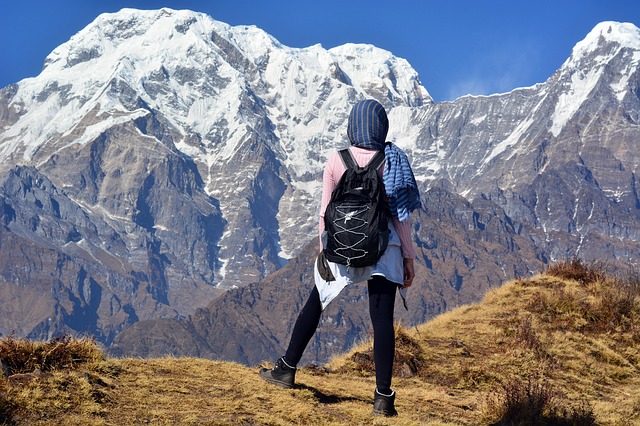Get rid of your trekking problems once and for all.
One of the most adventurous activities to do in Nepal is trekking. The Himalayas have long been a hub for trekkers from all over the world. For its magnificent beauty, the Himalayas have also earned the name of “trekker’s paradise.”
With an intricate geographical build-up, the region has beautiful landscapes, diverse flora and fauna, rich cultural diversity, and breathtaking mountains. All of these factors put together the reasons for trekkers opting for a journey here.
But trekking here isn’t easy. Trekkers face a plethora of challenges and issues that make it challenging to complete their journey in the Himalayas. Here are some challenges trekkers face while trekking in Nepal.
Altitude Sickness
Challenges
One of the most dangerous and fatal aspects of high altitude traveling is altitude sickness. Especially when trekking in Nepal, you will be traveling around high altitudes from 2000 to 3000 meters and above.
Altitude sickness is a major risk factor that challenges almost all trekkers. Most people fail to overcome this obstacle and fail their trek. It is crucial to know what altitude sickness is. Since it has no immediate cure, the only possible thing to do is prevent it.
Solution
As mentioned, the best way to deal with this problem is to prevent it from happening. There are various ways to avoid altitude sickness. A straightforward way to do so is by maintaining a decent pace, which allows your body to adapt to the changing altitude levels.
Next, you can spend an additional day in between stops for acclimatization. If you are feeling uncomfortable or are experiencing symptoms of altitude sickness, inform the guide or your partners immediately. The only way to deal with it once it affects you is to descend in altitude.
Fatigue and Tiredness
Challenges
Fatigue and tiredness can come quickly to trekkers. Trekking all day long with a heavy backpack can cause extreme physical and mental exertion to the body. If you are not maintaining proper levels of hydration and nutrition, you can start feeling weak and exhausted.
Solution
The most basic way to combat fatigue and tiredness is to maintain a proper diet and sleep. Eat enough nutrients, food, and drink plenty of water. The minimum recommended amount of water per day is 3 liters. Next, you should rest enough at night to recharge your body for the next day. Regulating these three factors can help prevent fatigue and tiredness.
Khumbu Cough
Challenges
The Khumbu cough, also known as the high altitude hack, got its name from the Everest region (Khumbu) in Nepal. Khumbu cough is a type of sickness that is caused by low humidity and sub-zero temperatures.
The Khumbu cough results in an increased breathing rate, which exposes the lung linings to the surrounding cold air. This causes the lung membranes to dry out and damages the bronchi. Symptoms include extreme irritation, persistent dry cough, running nose, and clear/white phlegm.
If you are planning for Everest Base Camp Trek, you must know about the cough and caring procedure.
Solution
There are a few techniques that can be used to prevent getting the Khumbu cough. The primary purpose of these methods is to regulate body temperature. The methods are:
- Wear a warm balaclava
- Keep your throat and chest area warm
- Avoid overexertion to your body
- Regulate breathing while trekking
Bad Trip Planning
Challenges
One of the reasons why trekkers fail their trek is due to lousy trip planning. It is essential that you plan your trip correctly and have good knowledge of the places you will reach. Bad trip planning is generally associated with trekking routes, time plans, budget allocations, and similar topics. A trip that isn’t appropriately planned is full of inconveniences. You might not reach your destination in time, or you might not have rooms to stay for the night.
Solution
It is highly recommended that you travel with a local tour operator. Tour operators organize the entire course of the trip for you with the given fee costs. They also provide you with a guide if needed. Guides can be beneficial in terms of receiving information about the trek and during emergencies. If you want to travel by yourself, you will have to do detailed research on different routes and their accessibility and feasibility.
Blisters and Leg Pain
Challenges
Trekking all day inevitably leads to leg pain and blisters. Treks in Nepal, on average, have 4 to 6 hours of walking per day. If a person is not well experienced or fit enough, the degree of leg pain can get higher accordingly.
Blisters are caused by the constant rubbing of the feet on the surface of the shoes/socks while walking. The skin is deprived of moisture when this happens, causing blisters. Blisters can be painful and frustrating.
Solution
To prevent getting blisters, you should wear good quality socks and shoes that are of the correct fit. Try to break your shoe flexibility beforehand so that they are comfortable with the real trek. Take breaks between walks and clean your feet with water from time to time. To ease leg pain, practice strength exercises a decent time ahead of the trek. You can do various exercises such as running, squats, lunges, etc. to build up body strength.
Problems mentioned above are some of the primary reasons why people fail to complete their journey. Some manage to return on their own while some require emergency evacuations. However, proper planning and preparation always go a long way. If you can handle these two factors, you can have a successful trip that will reap you boundless joys and beautiful experiences.
This experience might be the reference for the trekkers and travellers around the world. Have a nice journey!

